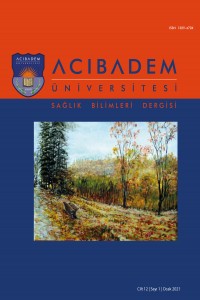Students’ Home Visit Experiences within the Scope of Public Health Nursing Course: A Qualitative Study
Abstract
Purpose:The purpose of this study was to explore the experiences of nursing students’ home visits within the context of the public health nursing course.
Patients and Methods:This was a qualitative descriptive study based on student’s reflective essay. The study was completed with 110 senior students in the nursing faculty of a public university in Turkey. Students explained self-perceptions (abilities, skills and feeling) before and after home visits process of public health nursing field practice in the end of semester.
Results:The experiences of students before the field practice were grouped under the themes of \"security\", \"concerns about the family process\" and \"feeling insufficient\". The themes “job satisfaction”, “being useful to the families”, and “contribution to personal development” emerged from the data collected after the field practice was completed.
Conclusion:This brief educational intervention allows students to felt useful to the families and the practice contributed to their personal development. It can be improved the readiness of students for home visits with undergraduate programs because nursing students meet “real world”.
References
- 1. World Health Organization. A framework for community health nursing education. 2015. Retrieved from: http://www.searo.who.int/entity/nursing_midwifery/documents/SEA-NUR-467/en/. Rerrieved Date: 21.05.2017
- 2. Maurer F.A. Smith C. M. Community/public health nursing practice: Health for families and populations. Elsevier Health Sciences, 2013: 290-300.
- 3. Oermann M. N. Annual Review of Nursing Education. United States of America: Springer Publishing Company, 2003.
- 4. Clement I. Management of Nursing Services and Education-E-Book. India: Elsevier Health Sciences, 2015.
- 5. Kahraman S. Erkek Öğrenci Hemşirelerin Halk Sağlığı Stajında Yaşadıkları Endişe ve Deneyimler: Şanlıurfa Örneği. Turk J Public Health 2013; 11(3): 207-211.
- 6. Altay B, Özge Ö.Z. Hemşirelik Bölümü Son Sınıf Öğrencilerinin Halk Sağlığı Kapsamında Yaptıkları Ev Ziyaretlerinde Karşılaştıkları Güçlükler Ve Profesyonel Hemşirelik Rolleri. Samsun Sağlık Bilimleri Dergisi, 2016; 1(1):1-12.
- 7. Starks H, Brown Trinidad S. Choose your method: A comparison of phenomenology, discourse analysis, and grounded theory. Qualitative health research, 2007; 17(10):1372-1380.
- 8. Eyler J. Reflection: Linking service and learning—linking students and communities. Journal of Social Issues, 2002;58(3):517-534. http://dx.doi.org/10.1111/1540-4560.00274
- 9. Perry S.L, Martin RA. Authentic reflection for experiential learning at international schools. The International Journal of Research on Service-Learning and Community Engagement. 2016: 4(1);53-68.
- 10. Leh S.K. Nursing students’ preconceptions of the community health clinical experience: implications for nursing education. Journal of Nursing Education, 2011: 50(11); 620-627. https://doi.org/10.3928/01484834-20110729-01
- 11. Duah M.A. Baccalaureate Nursing Students’ Perceptions of Community Health Nursing as a Career (Doctoral dissertation, Université d'Ottawa/University of Ottawa) 2015.
- 12. Kendra M.A, George V.D. Defining Risk in Home Visiting. Public Health Nursing. 2001;18(2): 128-137.
- 13. Babenko-Mould Y, Ferguson K, Atthill S. Neighbourhood as community: A qualitative descriptive study of nursing students' experiences of community health nursing. Nurse Educ. Pract, 2016:17; 223-228. https://doi.org/10.1016/j.nepr.2016.02.002.
- 14. Ozkan O, Ozdemir, S. Outcomes of planned home visits of intern public health nurses: An example from Turkey. Annals of Global Health, 2016;82(5): 885-896.
Halk Sağlığı Hemşireliği Dersi Kapsamında Yapılan Ev Ziyaretlerine İlişkin Öğrenci Deneyimleri:Nitel Araştırma
Abstract
Amaç:Bu çalışmanın amacı hemşirelik öğrencilerinin halk sağlığı hemşireliği dersi kapsamında yaptıkları ev ziyaretlerine ilişkin deneyimlerinin tanımlanmasıdır.
Hastalar ve Yöntem:Bu tanımlayıcı nitel araştırma Türkiye’deki 110 son sınıf öğrencisinin görüşlerini yansıtmaktadır. Öğrencilerin halk sağlığı hemşireliği saha uygulaması öncesi ve sonrası deneyimlerini açıklamaktadır.
Bulgular:Öğrencilerin saha uygulama öncesi deneyimleri “güvenlik”, “aile sürecine ilişkin endişe” ve “kendini yetersiz hissetme” ana temalarından oluşmuştur. Öğrencilerin saha uygulama sonrası deneyimlerinden elde edilen veriler doğrultusunda ise “iş doyumu”, “ailelere faydalı olma” ve ” kişisel gelişime katkı” başlıklarının öne çıktığı görülmüştür.
Sonuç:Bu kısa eğitim uygulaması, öğrencilerin ailelere faydalı olmalarına ve kendi kişisel gelişimlerine katkıda bulunmalarına yardımcı olmuştur. Öğrencilerin lisans programlarıyla ev ziyaretlerine hazır olmaları geliştirilebilir, bu sayede hemşirelik öğrencileri “gerçek dünya” ile karşılaşır.
References
- 1. World Health Organization. A framework for community health nursing education. 2015. Retrieved from: http://www.searo.who.int/entity/nursing_midwifery/documents/SEA-NUR-467/en/. Rerrieved Date: 21.05.2017
- 2. Maurer F.A. Smith C. M. Community/public health nursing practice: Health for families and populations. Elsevier Health Sciences, 2013: 290-300.
- 3. Oermann M. N. Annual Review of Nursing Education. United States of America: Springer Publishing Company, 2003.
- 4. Clement I. Management of Nursing Services and Education-E-Book. India: Elsevier Health Sciences, 2015.
- 5. Kahraman S. Erkek Öğrenci Hemşirelerin Halk Sağlığı Stajında Yaşadıkları Endişe ve Deneyimler: Şanlıurfa Örneği. Turk J Public Health 2013; 11(3): 207-211.
- 6. Altay B, Özge Ö.Z. Hemşirelik Bölümü Son Sınıf Öğrencilerinin Halk Sağlığı Kapsamında Yaptıkları Ev Ziyaretlerinde Karşılaştıkları Güçlükler Ve Profesyonel Hemşirelik Rolleri. Samsun Sağlık Bilimleri Dergisi, 2016; 1(1):1-12.
- 7. Starks H, Brown Trinidad S. Choose your method: A comparison of phenomenology, discourse analysis, and grounded theory. Qualitative health research, 2007; 17(10):1372-1380.
- 8. Eyler J. Reflection: Linking service and learning—linking students and communities. Journal of Social Issues, 2002;58(3):517-534. http://dx.doi.org/10.1111/1540-4560.00274
- 9. Perry S.L, Martin RA. Authentic reflection for experiential learning at international schools. The International Journal of Research on Service-Learning and Community Engagement. 2016: 4(1);53-68.
- 10. Leh S.K. Nursing students’ preconceptions of the community health clinical experience: implications for nursing education. Journal of Nursing Education, 2011: 50(11); 620-627. https://doi.org/10.3928/01484834-20110729-01
- 11. Duah M.A. Baccalaureate Nursing Students’ Perceptions of Community Health Nursing as a Career (Doctoral dissertation, Université d'Ottawa/University of Ottawa) 2015.
- 12. Kendra M.A, George V.D. Defining Risk in Home Visiting. Public Health Nursing. 2001;18(2): 128-137.
- 13. Babenko-Mould Y, Ferguson K, Atthill S. Neighbourhood as community: A qualitative descriptive study of nursing students' experiences of community health nursing. Nurse Educ. Pract, 2016:17; 223-228. https://doi.org/10.1016/j.nepr.2016.02.002.
- 14. Ozkan O, Ozdemir, S. Outcomes of planned home visits of intern public health nurses: An example from Turkey. Annals of Global Health, 2016;82(5): 885-896.
Details
| Primary Language | English |
|---|---|
| Subjects | Clinical Sciences |
| Journal Section | Research Articles |
| Authors | |
| Publication Date | December 16, 2020 |
| Submission Date | July 19, 2019 |
| Published in Issue | Year 2021Volume: 12 Issue: 1 |


